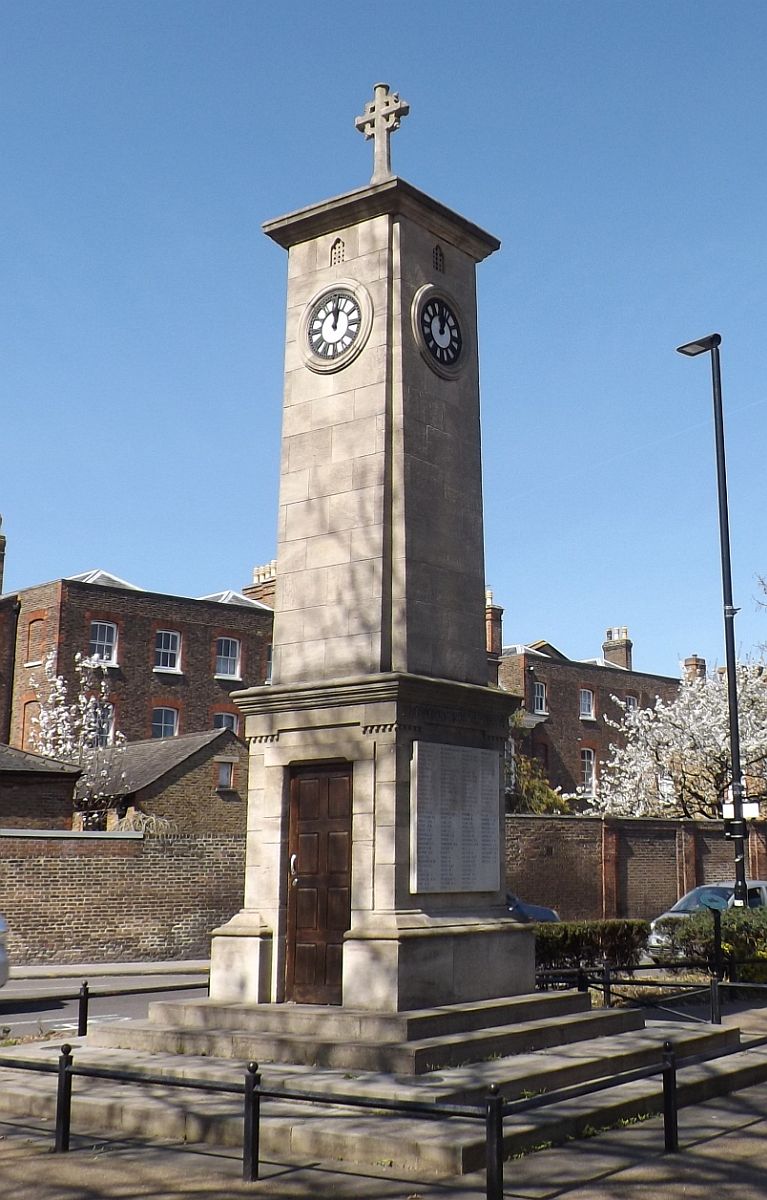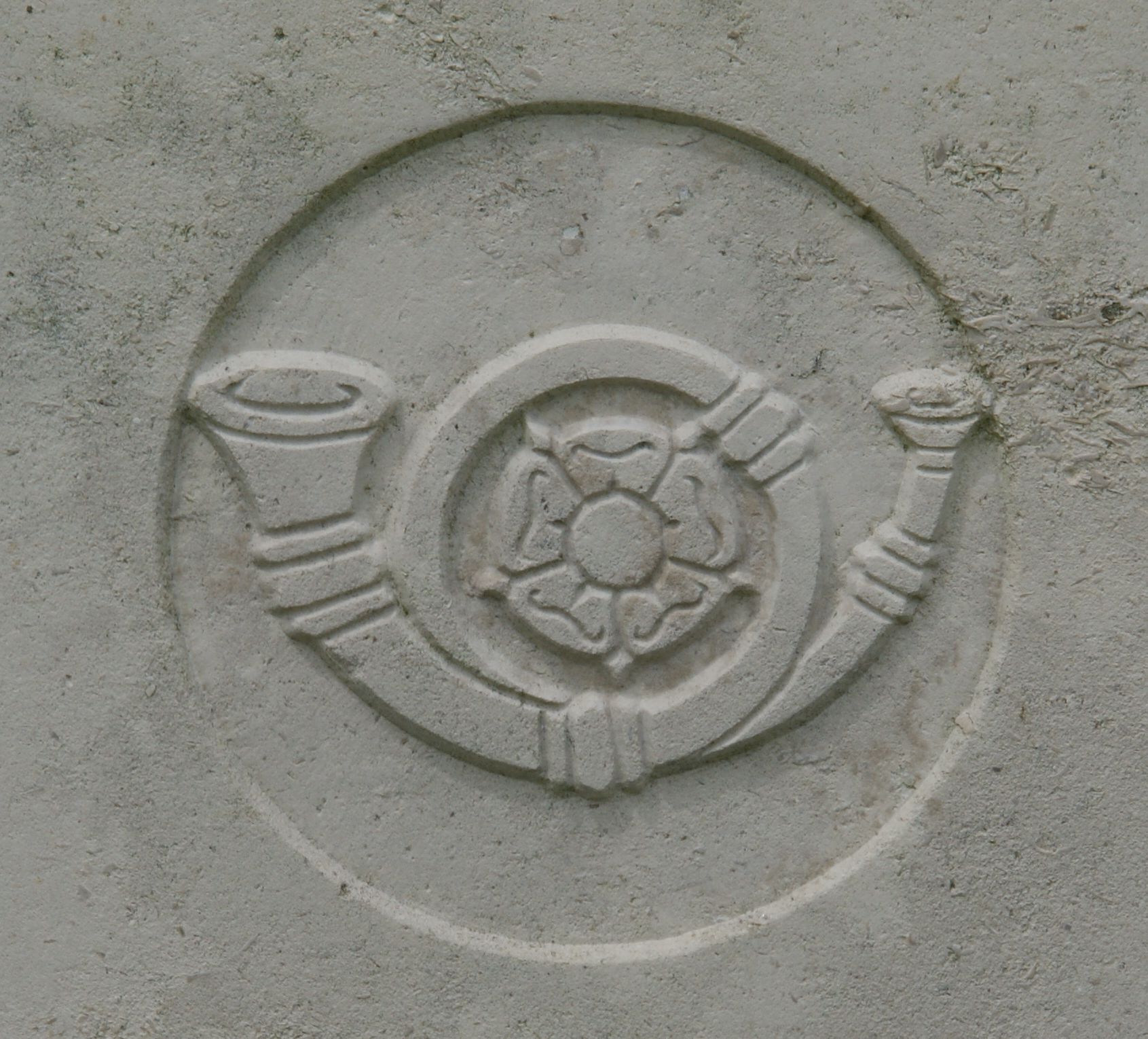Charles Mundy
Private 23303 Charles Mundy, 2nd Battalion, King’s Own Yorkshire Light Infantry
 Isleworth War Memorial - Charles is remembered in his home town as well as Newbury. |
Charles was born in Isleworth in 1883 the second son of Arthur Mundy and his wife Elizabeth (née Leach). The couple had four children (William, born 1881; Charles, 1883; Henry, 1884; and Ethel, 1888) before Elizabeth died in 1892 aged only 39. Left with a young family to raise Arthur chose a common solution and remarried within a year to Ellen Brown, with whom he had one more child, Albert Edward, in 1895. The family lived in Isleworth in west London where Arthur worked for the council as a ‘sanitary labourer’.
Charles joined the army young, in the 1901 census he is recorded as being aged 19 – as he was no more than 18 at that time it would appear that he had lied about his age in order to enlist as an adult (18). He was serving with the 19th (Queen Alexandra's Own Royal) Hussars (No 5044) stationed at the Sturry Road barracks in Canterbury, Kent. Soon after this he went out to South Africa earning the award of the Queen’s South Africa Medal with clasps for Orange Free State, Transvaal, South Africa 1901 and South Africa 1902. He did not qualify for the King’s South Africa Medal because he did not have sufficient qualifying service in the conflict area (a minimum of 18 months prior to 1 June 1902). The 19th Hussars were in South Africa when the Boer War began in 1899, so Charles’ time with the regiment in Canterbury would have been as a new recruit training to be ready to join the regiment proper.
Service in the Army at that time was usually on the base of a 12 year commitment, which could be entirely spent in uniform or could be split into a period (most commonly 7 years) with the colours followed by the remainder of the 12 year term spent in civilian life as a member of the Reserve, liable to instant mobilisation. After 12 years men could also sign on for further service – leading towards a pension after 22 years. Alternatively they could sign on for four more years in the Reserve receiving a weekly payment for very little peacetime commitment.
It seems quite likely that he transferred to the 13th Hussars in 1904, when the regiment’s numbers were made up to strength in preparation for a move to overseas service in India. His regimental number was issued around this time.
In the absence of his service record (70% of WW1 servicemen’s records were destroyed by a fire in 1940) it is not clear what Charles’ service comprised, but there is every chance that he opted to make a career out of the army. When war was declared in 1914 the regular army based in England was mobilised for action – which included the call up of the Reserve. Charles crossed to France, seemingly with the 13th Hussars, in August 1914 (landing in France on the 21st).
However, this information is misleading – the 13th Hussars still were in India when war was declared and didn’t arrive in France until December 1914 when they landed in Marseilles as part of the 2nd Indian Cavalry Division. So Charles cannot have served with them in August! Over 100 13th Hussars are on the 1914 Star medal roll – the qualifying date for which (22 November 1914) had passed before their regiment was in France. The regiment would have had a home based unit responsible for the recruitment and training of men who would then be sent to the regiment overseas as well as a number of men on the Reserve. The 1914 Star recipients must have come from this group, but where and how they fitted into the British Expeditionary Force is a mystery – perhaps they were sent to bolster the numbers of British based cavalry units?

The regimental badge of the King's Own Yorkshire Light Infantry, as used on CWGC headstones. |
However Charles served in the early months of the war, it is known that he was transferred to an infantry unit, the King’s Own Yorkshire Light Infantry (2nd Battalion), on 5 June 1915 and received another regimental number (23303). He spent the following two years at the front with his battalion, hopefully broken by a chance or two to get home on leave.
He certainly got some leave because he was in Newbury in 1917 when he married Emily Mary Cook at the parish church of St Nicolas on 4 July.
His death on 14 September 1917 is another mystery – his battalion reported that no casualties were incurred that day or the following (the diary records casualties from noon to noon rather than calendar day).
14 September Owing to the gas attack no patrols were sent out with the exception of listening patrols. The day was, on the whole, a quiet one, with the average amount of enemy promiscuous shelling. No casualties were sustained up to 12 noon today.
Nevertheless, Charles was reported ‘killed in action’ on 14 September. He was buried in grave III.G.28 at Coxyde Military Cemetery – alongside a number of casualties from his battalion killed in the same month. Row III.G was filled day by day with casualties from various units in the area – Charles being the third victim of 14 September to be buried. It can only be assumed that his death was overlooked by the battalion diarist, perhaps he fell victim to the enemy’s ‘promiscuous shelling’?
The news was also overlooked by the local paper back in Newbury, it was not until the following year that it marked his passing when his wife inserted a notice in the ‘Family Announcements’ column:
In loving memory of Pte C Mundy, killed in action in France September 14, 1917. – Gone but not forgotten.
No loved ones stood beside him,
He gave no last farewell;
Not a word of comfort could he have
From those he loved so well.
From his sorrowing wife.
 Charles' name on Newbury War Memorial. (top left) |
Locally he is remembered on Tablet 3 of the Newbury Town War Memorial (as C Munday), the parish memorial board and roll of honour in St Nicolas’ Church (as C Mundy).
The misspelling of his name on the town memorial is very likely to have occurred in 1950 when the original, much worn, stone tablets were replaced by the existing bronze tablets. A number of other errors are known to have been introduced at this time. On the order of service for the dedication and unveiling ceremony his name is spelt correctly.
He is also remembered on Isleworth War Memorial and on the website for the Isleworth390 Project.

Find a memorial :
| Died this day: | |
| 14 January 1944 | |
| R G Layley | |
| Newbury |

Like this site? Show your appreciation through a donation to a great charity.